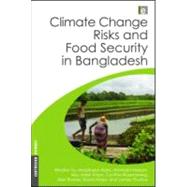
Note: Supplemental materials are not guaranteed with Rental or Used book purchases.
Purchase Benefits
What is included with this book?
| List of Figures and Tables | p. vii |
| Acknowledgements | p. xi |
| Foreword | p. xiii |
| Executive Summary | p. xv |
| Glossary of Terms | p. xxi |
| Acronyms | p. xxiii |
| Introduction | p. 1 |
| Objective of Study | p. 2 |
| Literature Review | p. 2 |
| Integrated Modelling Methodology | p. 3 |
| Organization of Study | p. 4 |
| Vulnerability to Climate Risks | p. 5 |
| The Success of Agriculture | p. 6 |
| Living with Annual Floods | p. 10 |
| Lean Season Water Availability | p. 15 |
| Sea level Rise in Coastal Areas | p. 17 |
| Regional Hydrology Issues | p. 19 |
| Future Climate Scenarios | p. 21 |
| Future Estimated Precipitation and Temperature | p. 22 |
| Future Sea level Rise | p. 26 |
| Future Flood Hydrology | p. 28 |
| GBM Basin Model Development | p. 28 |
| National Hydrologic Super Model | p. 30 |
| Approach to Modelling Future Flood Changes | p. 30 |
| Future Changes over the Ganges-Brahmaputra-Meghna Basin | p. 31 |
| Future Flood Characteristics and Analysis | p. 33 |
| Future Crop Performance | p. 41 |
| Development of the Baseline Period | p. 42 |
| Developing Flood Damage Functions | p. 46 |
| Incorporating Coastal Inundation Effects | p. 48 |
| Projections of Future Potential Unflooded Production (Climate Only) | p. 49 |
| Projections of Future Projected Flood Damages | p. 52 |
| Projections of Potential Coastal Inundation Damages | p. 53 |
| Projections of Integrated Damages | p. 53 |
| Using the Crop Model to Simulate Adaptation Options | p. 56 |
| Economy-Wide Impacts of Climate Risks | p. 60 |
| Integrating Climate Effects in an Economy-wide Model | p. 61 |
| Economic Impacts of Existing Climate Variability | p. 64 |
| Additional Economic Impacts of Climate Change | p. 72 |
| Adaptation Options in the Agriculture Sector | p. 82 |
| Identifying and Evaluating Adaptation Options | p. 83 |
| The Way Forward - Turning Ideas to Action | p. 105 |
| A Framework for Assessing the Economics of Climate Change | p. 107 |
| Using DSSAT to Model Adaptation Impacts | p. 108 |
| Description of the CGE Model | p. 113 |
| Constructing the Social Accounting Matrix for Bangladesh | p. 119 |
| References | p. 133 |
| Index | p. 139 |
| Table of Contents provided by Ingram. All Rights Reserved. |
The New copy of this book will include any supplemental materials advertised. Please check the title of the book to determine if it should include any access cards, study guides, lab manuals, CDs, etc.
The Used, Rental and eBook copies of this book are not guaranteed to include any supplemental materials. Typically, only the book itself is included. This is true even if the title states it includes any access cards, study guides, lab manuals, CDs, etc.